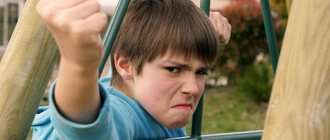Today, the number of various crimes committed by young people has increased. There has been a catastrophic surge in the spread of cruelty among schoolchildren. Adolescent cruelty is a hostile action aimed by a teenager at a specific individual or group of individuals in order to prove his superiority, strength and permissiveness. It is a common form of teenager’s protest against not understanding, not loving and not accepting him as a person. A person who feels unwanted, unloved, and not accepted by society often displays his immoral behavior, cruelty, and aggressiveness as a way of reflecting his inner world, suffering, and inner pain. Trying to get rid of or defuse internal disharmony, the teenager expresses his contradictions through cruel behavior aimed at humiliating weaker individuals or animals.
During the period of frustration of a teenager’s internal needs, tension accumulates within the individual. Unable to withstand such internal overstrain, the growing child discharges himself through cruelty and aggression. These teenagers are often labeled in schools as “difficult children” or “neglected children.” Often they are isolated from the group and no one cares about them, those around them are of little interest in what is going on inside the child, he is credited with a difficult, or even worse, criminal future. This type of response to adolescents contributes to the development of even more cruel behavior and self-will. If a minor does not have severe psychological disorders, the level of aggressiveness and cruelty can be dealt with at the level of the school psychological service, with the help of the interaction of teachers, parents and the child himself, the main thing is not to neglect the child.
Causes of teenage cruelty
An act of cruelty directed at a person who is weaker or younger (and therefore less protected) is not a traditional way of acting for a teenager, these are problems of the internal nature of the subject. For the most part, children with such tendencies come from problematic families or have experience of personal humiliation. The object of their retribution is not the offender (he is, accordingly, stronger than the teenager), but the weaker individual, often these are younger children, lower in social status, raised in families with one adult.
A subject who takes out resentment and aggression on others has disturbances in the emotional sphere of life. During the period of development of a teenager, the emotional component of the psyche is not sufficiently formed; it is in the development stage, which indicates a fragmentarily formed concept of the value of one’s life and others. When committing an act of violence against another person, a teenager is not able to correlate how emotionally and physically painful it is for the object being bullied. This is a consequence of the individual’s unformed ability to show empathy and feel the experiences of the victim, to put oneself in her place.
The ability to show empathy in a person is formed in preschool age, at the time of interaction with parents. Consequently, the cause of cruelty in minors is parental irresponsibility during upbringing. This is not the only possible factor in the development of immoral behavior; in order to determine the next ones, we need to dig a little deeper. Often, offenses committed by teenagers are committed under group pressure. The group mechanism of pressure can persuade a teenager who has no desire to be aggressive to commit violence. The initiator of violence demonstrates to others his “coolness”, that he is able to afford a lot, thereby encouraging each member of the group, convincing them that strength is on their side.
Adolescent cruelty is a personality trait characterized as the inability to notice the suffering of others or to take actions aimed at inflicting this suffering. An individual's character traits are not innate; they are acquired during the formation of the individual as a personality. Research by psychologists from Canada has shown that at two and a half, three years old, a child is at the peak of aggressiveness and cruelty. This is provoked by unformed social norms; during this period it is difficult for children to learn prohibitions and rules of behavior. It is this age that is considered the most significant when raising a non-cruel and non-aggressive individual. It depends on the parents how they will be able to redirect the child’s inappropriately cruel behavior into a peaceful type of behavior. First of all, this depends on the very type of behavior of adults, how friendly and peaceful they are, how much they can cope with their cruelty and aggression.
So, describing one of the important reasons for the emergence of cruelty in a teenager (upbringing in the family), it should be said about several directions of influence. Indifference to the child’s problems and lack of support contribute to the formation of an emotional vacuum in the child, which subsequently develops into the inability to control emotions independently. During adolescence, an individual experiences serious emotional and psychological pressure, and therefore needs understanding and support, especially from people close to him. In a cell of society with a high social status, where there is no need for either clothing or food, he often needs care.
Parents who are passionate about work and career growth ignore the needs of the child, buying him off with gifts or freedom of action. It is important to develop in a teenager the ability to recognize his own feelings and control them. To do this, parents themselves must become an example and should not hide their own emotions, even if it is sadness or anger. The child must clearly understand how certain negative manifestations can be expressed more calmly, without causing harm to others and, most importantly, to himself. The ability to notice and understand the emotions of their children allows parents to raise and raise children who are capable of being emotionally open, with the ability to show a sense of empathy, and to be aware of the emotional and physical pain that they can inflict on others.
The opposite of indifference is “blind”, excessive care. Such parental love neglects the child’s individuality and the desire to make decisions independently. Making decisions independently helps the teenager learn from his own mistakes. Over time, a child, surrounded by maximum care, turns into a naughty, uncontrollable teenager with an obsessive desire to show his parents his independence, that he can do whatever he wants at his own discretion. Often this is expressed in cruel actions with peers, with animals, and less often with oneself.
Another reason for the cruelty of a teenager is the environment of his life, that is, the dysfunction of the family itself. If a teenager has observed violence and cruelty in the house since childhood (it is possible that he himself was the victim), his tendency towards identical behavior has been proven by psychologists. Of course, not every teenager whose family is dysfunctional or where one adult suffers from addiction grows up to be cruel or aggressive. But the negative example set by adults has a negative impact on the development of the child’s psyche. This can develop into the formation of aggressiveness aimed at children who are more fortunate with their family.
School is another stage in the development of a student’s personality. Here, the influence of classmates and teachers have a special impact on the development of cruelty in a child. Often, conflicts with teachers, plus a colossal academic load, affect the already shaky psyche of a teenager. Unrequited love can also add to all this.
Teenage and child cruelty is often more noticeable in the context of school problems. Therefore, teachers and the psychological department need to be as attentive as possible to students, having noticed a change in the subject’s behavior, they need to trace any of its manifestations in order to eradicate the emergence of cruelty at an early stage.
Since a teenager’s living environment has a special impact on the formation of behavioral characteristics at such an important age, the phenomenon of teenage cruelty may be the peer group into which the child ends up. It has been repeatedly noticed that yesterday a calm and balanced schoolboy, today beats or “poisons” some child. Changes in a teenager’s social circle with not the most decent individuals contribute to the desire of a child (even an obedient one) to prove his “coolness” in order to be accepted. Accordingly, the result may be the development of violent behavior and aggression.
One of the reasons for the emergence of an imbalance in the behavior of a teenager is the natural component, which directly during the period of maturation of an individual’s body implies physical and psychological changes, which are ensured by the release and change in the amount of hormones in the blood of a teenager. Hormone surges in a teenager’s body lead to the individual’s inability to control emotional outbursts, which develop into problematic relationships with family and friends. Faced with these unexpected changes, the teenager adapts to them with inexplicable cruelty and aggression.
Modern culture, the development of computer games, their cruelty and impunity force children to be overwhelmed by constant tension and a feeling of anger. Psychologists-scientists who study the influence of games and culture on individual behavior have proven an increase in the level of cruelty in the behavior of adolescents who are highly interested in various types of violent games, films or culture. Teenage and child cruelty is directly related to the passion for computer games, which are even capable of destroying the individual’s psyche, especially at such a vulnerable age.
Combination of factors
It is worth noting that the combination of unfavorable psychological, biological, family and other social factors distorts the lifestyle of children. It becomes typical for them to have a violation of emotional relationships with people around them. They come under the great influence of a group of leaders, who often form asocial life values. Teenagers' lifestyle, culture, environment, social circle and style contribute to the development of deviant behavior.
A negative microclimate in different families causes the appearance of rudeness, alienation, hostility of some teenagers, as well as the desire to do everything against the will of their elders, out of spite. This creates the preconditions for the emergence of demonstrative disobedience, destructive actions and aggressiveness.
Aggression and cruelty of adolescents
The problem of teenager cruelty and aggressive manifestations of behavior has not been denied in any society or nationality throughout the existence of man on earth. The violent behavior of teenagers, as a way of expressing individuality, importance and omnipotence, poses impossible tasks for psychologists and society as a whole, which they deal with every day. With the development of the Internet and other media, the level of cruelty among the entire population, especially teenagers, is increasing. The fact of such a relationship has been repeatedly proven, although this topic has gained relevance thanks to discussions on the Internet, in newspapers, on television, and so on. That is, aggression has always existed in the social circles of teenagers, but the intensity of concentration around it began to increase quite recently. Today, the development of effective ways to combat the phenomenon of violence and cruelty is at a fairly high level, and there are a lot of organizations and programs aimed at reducing the level of aggression: reconciliation services, psychological support services, both public and school, the introduction of school mediation, when teenagers speak out themselves acting as mediators in various disputes and conflicts, contributing to their peaceful resolution or preventing their occurrence.
Aggression as a property of a teenager is manifested in his readiness for such behavior. Aggression and cruelty in minors is an individual-personal characteristic that affects the life of the individual and the lives of those around him. The emergence of such personality traits today is seen in both sexes equally. Obscene language, smoking, alcohol, entertainment associated with insulting and bullying others (American psychologists call this behavior “bullying,” now often used in our scientific paradigm) have become the norm. Often, when punishing a teenager for his behavior, the teenager has a misunderstanding: “why?”, “what did he do if everyone does this.”
A teenager’s predisposition to such behavior can be conscious or unconscious. Based on this, psychologists focus on several types of manifestations of aggression: direct physical aggression; resentment, hatred and envy; indirect aggression; verbal aggression; negativism; suspicion; irritation; guilt. Like cruelty, aggressive behavior arises in the process of education and development of the individual. But why does a child, even from a prosperous upbringing environment who studies in a good school, suddenly become a cruel person? Mostly, this is a child’s cry for help, that he needs attention.
Children who display aggressive and cruel behavior have a low level of intellectual development and are prone to imitation. Violent teenagers lack value orientations and hobbies; narrowness and instability in their hobbies predominate. Such adolescents are characterized by emotional embitterment, rudeness, increased anxiety, egocentrism and the manifestation of extreme self-esteem (maximum negative or positive). The aggressiveness and cruelty of adolescents is a means of raising their own prestige, independence and adulthood.
Cult of Malice
There is a huge amount of evidence that confirms that even in completely normal families, embittered children sometimes grow up. Therefore, family well-being does not guarantee that a child, if necessary, will lend a helping hand to someone in need. Cruelty among teenagers has mostly deeper causes. Often it arises due to school education. Not every teacher today will go to find out the true cause of the conflict between the students in his class.
A child's character begins to emerge in early childhood. It is not difficult for a class teacher to identify which student is the leader, who is the “whipping boy,” and who often shows aggression towards other people. Do not ignore the tense atmosphere that has arisen in the class.
There are sad results of how the bullying of a student by his classmates can end. You can't pretend that nothing happened. It is possible to even save a child's life with timely intervention. Many teenagers, feeling like outcasts, are on the verge of suicide. Violent children begin to bully the child, which is completely unacceptable. This is a situation out of the ordinary. It is necessary to apply all pedagogical skill in order to correct this situation.
When a child sees that no one is paying attention to the abuse, the bullying becomes even worse. It is necessary to gather the class as often as possible for an explanatory conversation, and also try to find common points of contact and interests. Often such control gives positive results.
The child is a victim
To identify this problem, it is necessary to carefully monitor the behavior of a teenager when he comes home from school. You should pay attention to minor, slightest changes in his usual behavior. Every mother will see if a child suddenly loses the desire to go to school, that he sometimes comes in torn things, and has lost his appetite. These are signs of a problem. You should have a heart-to-heart talk with him. Of course, it will be very difficult to bring him into such a conversation. Not every family has trusting relationships. You should show your daughter or son from an early age that parents are the best and most reliable friends.
If a child has a conflict with his peers, it will be much easier to find a way out together. If he doesn’t want to share, you need to try to be kind and careful. You should not ask for information under pressure. Show him that you are on his side entirely. Probably in this case he will consider it necessary to ask for help and open up.
In this case, the child fears that he will only aggravate his difficult situation with such revelations with loved ones. He believes that the desire to tell everything to parents is an indicator of weak character. You need to convince him that this is not so.
Together you can choose an adequate solution and find the right way out of the current conflict. Don’t mock children’s problems by declaring that it’s all nonsense. Such an attitude can greatly offend a vulnerable young soul.
News sites have recently been literally filled with various materials about cases of increased aggression in adolescents. At the same time, the abundance of computer games with various elements of violence and reprisals does not have the best effect on the child’s psyche. A large number of teenagers tried to commit suicide after being beaten by classmates. In addition, such scenes, as mentioned above, are filmed and posted for public viewing on the Internet.
Internet, television
Teenage violence has increased to alarming proportions in the 20th and 21st centuries. Experts see the reason for this in the accessibility and spread of the Internet and television. The most exciting and popular films necessarily contain scenes of violence that have a strong impact on children's unformed psyche. Various computer games involve killing and fighting to win. Videos that show debauchery, irresponsibility and rudeness are freely available on the Internet.
Our children have become bored with “just” fighting - it is necessary to film it on the phone, and then post the video online. What to do with it? Divert the child’s attention to other, constructive activities, and also provide arguments in defense of the fact that cruelty and aggressiveness are not “cool” at all.
Friends
Almost all children perceive peer criticism more sensitively than parents’ arguments. The problem of “bad company” always remains acute - an aggressive and arrogant child is able to set an example and tone of behavior for a group of children, while the desire to match his style and internal dissonance only aggravate the cruelty of adolescents.
The way out of this situation will be the gradual development of new interests and values: it is necessary to “feel out” what exactly interests the child - sports, dancing, creativity, etc. He will be able to devote more time to his hobbies, and there he will make other friends, in which he only needs to be encouraged.
School
Almost every student has encountered at least once the most common difficulties - misunderstandings from teachers or rejection by classmates. A child, and even more so a beginner, can thus become an object of bullying and an outcast from other students for various reasons - he can be an adherent of a different religion, belong to a different nationality, be stupid, smart, or have peculiarities in appearance. The cruelty of teenagers knows no boundaries; they can treat their peers unfairly just because they are different from everyone else.
For the same reason, they may be attacked by some teachers. The scandalous, sensational film “School” by Valeria Gai Germanika tells the story of the difficulties of today's secondary education institutions.
Family
Child psychologists and specialists around the world are trying to figure out the reasons for the increased aggression that teenage girls and boys are now susceptible to. They come to the conclusion that it is primarily in the family that processes occur that contribute to the formation of the child’s embitterment. Oddly enough, it is mainly caused by parental blind love.
If, for example, parents take care of and protect their child, while not seeing him as an individual and not appreciating his individuality, a desire arises in his soul to prove and show that he is capable of doing something in his own way and by himself. And along this path, teenage girls and boys often commit aggressive acts towards the people around them. In order to avoid this situation, the child needs to be given the right to choose, given personal space, without losing control.









